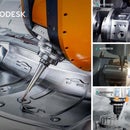Introduction: Introduction to Milling
In this first lesson, we will program a basic part utilizing PowerMill's traditional machining strategies. However, before we dive into our first part, we will first take a look at the workflow of programming parts in PowerMill. Whether you are programming the parts in this class, or your own parts in your shop, this worflow will help guide you through the programming of any part in PowerMill.
Step 1: Introduction to the Workflow
Whether you are new to PowerMill, or manufacturing in general, this class will help you build a solid foundation in PowerMill by focusing on the fundamental workflow of PowerMill. While each part we program in this class will differ, the workflow we follow to program them will always remain the same. At the end of this class, you will be able to utilize the workflow outlined in this class to tackle any project you may encounter in your shop. Whether you are working on a basic training part from this class, or a complex 5-axis aerospace or mold part in your shop, you can approach the programming process for each part with this same basic workflow to help ensure you part is programmed as safely and efficiently as possible.
- Setup: Import your own model, and prepare your part for programming.
- Tool: Create a tool to be used in a given machining strategy.
- Toolpath Strategy: Indicate a strategy to be used to machine your model's surfaces.
- Settings: Customize both cutting and non-cutting portions of the newly created toolpath.
- Verify/Simulate: Visualize the machining of your part, while ensuring that the program is safe to run.
- Revise: Make any necessary changes to the toolpath based on verification/simulation results.
- NC Code: Generate the code required to physically machine you part.
Step 2: Setup
- Open PowerMill, import instructables model into PowerMill
We need to create a block to machine our part from.
- Select
the block option from the home tab
- Calculate the block size and apply

Calculate the toolpath safe area:
- Open
the toolpath connections dialog from the home tab
- Select calculate on the right-hand side of the dialog box for safe area
- Apply the changes and close the dialog

With our model imported, block set up, and toolpath connections calculated, we are ready to begin programming!
Attachments
Step 3: Roughing
Video 3: Roughing
First, we’ll create a tool for the roughing pass
- Create
a Tip Radiused Tool
- Length: 40 mm
- Diameter: 12 mm
- Tip Radius: 1 mm
- Name the tool D12TR1 and close the tool dialog

Now that we have our tool for the roughing pass, we can create the necessary toolpath
- Create
a Model Area Clearance strategy and name it D12TR1-RGH
- Offset Model
- Thickness: 0.5 mm
- Stepover: 5 mm
- Stepdown: 5 mm

- Calculate the Toolpath

- Run a ViewMill simulation of the roughing pass.
- Right click on D12TR1-RGH and select simulate from start. Click the red circle in the ViewMill section of the simulation ribbon to turn on ViewMill.
- Click the play button to run the simulation

With our model roughed, we are ready to finish programming the model by adding a finishing pass.
Step 4: Finishing
To get our part to have a clean finish, we will run a finishing pass across the block.
First, we’ll need to create the necessary tooling:
- Create
a ball nosed end mill for finishing the part
- Diameter: 8 mm
- Length: 30 mm
- Name the tool BN8 and close tool dialog
- Activate the tool
Now we’ll create the finishing toolpath using our ball nosed end mill.
- Create
a Raster finishing strategy and name it BN8-FIN
- Tolerance: 0.02 mm
- Stepover: 0.5 mm
- Calculate and close the dialog
- Run a ViewMill simulation for the finishing pass.
- Right click on BN8-FIN and select simulate from start.
- Click the play button to run the simulation
A warning pops up about a possible gouge when the tool approaches the boss.
- We
can add a radial clearance in the toolpath connections dialog
- Moves and Clearances
- Radial Clearance: 5 mm
- Apply and accept the dialog
- Run another ViewMill simulation of the revised finishing pass.
The model looks mostly finished after our finishing strategy, but some of the faces don’t quite seem to be up to par. It would appear to make sense to add another pass that runs perpendicular to our toolpath. Luckily, we can do that within our raster finishing strategy.
- Add
a perpendicular pass into the toolpath BN8-FIN
- Right click on the toolpath in the explorer and select settings
- Click the recycle button in the upper left corner
- Check the Perpendicular Pass option in the raster finishing section
- Recalculate the toolpath
- Run a new ViewMill simulation for our updated toolpath

The finish now appears uniform across our model. Feel free to experiment with the settings in the finishing toolpath to learn more about what every command does. Through experimentation of these settings you will quickly see how much control PowerMill gives us over the toolpath.
Step 5: NC Code
Our toolpaths have been simulated and appear successful, so now it’s time for us to generate the NC code.
- Right
click on NC programs in the explorer and select Create NC Program
- Give the program an appropriate name
- Right
click on NC programs in the explorer and select Preferences
- Select the desired postprocessor for our NC code
- Drag all toolpaths into the program and run a full
simulation.
- Right click on the program
- Simulate from Start
- Generate NC code by simply right clicking on the program and selecting Write.
Note: This exercise is for educational purposes. While this exercise outlines the process of generating your NC Code, no actual code is to be generated as a part of this class.














